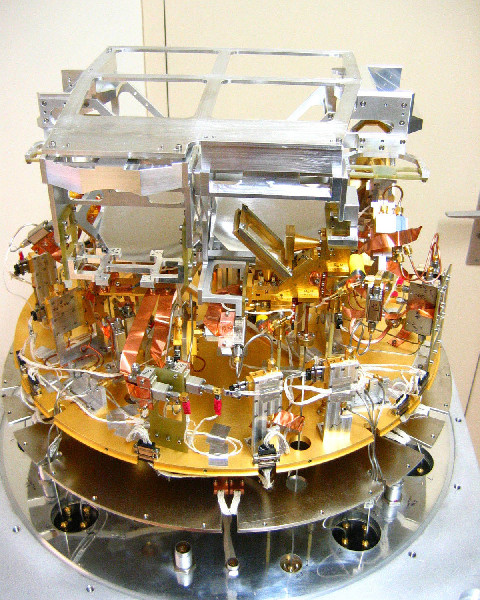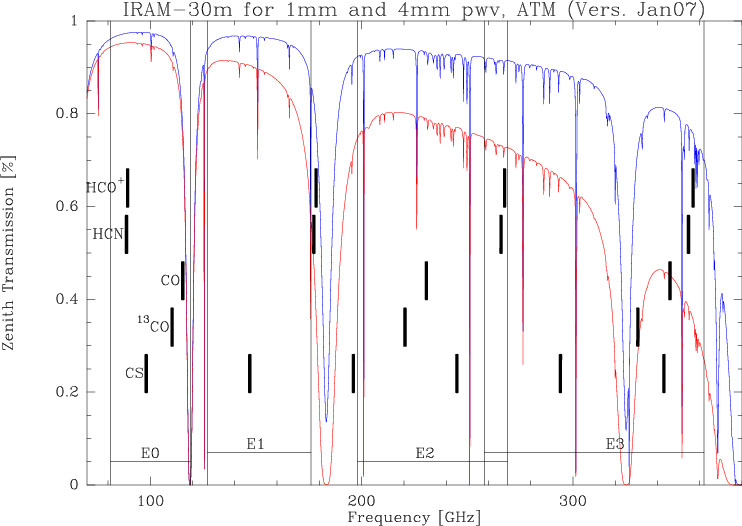
|
Proposals for three types of receivers will be considered for this summer semester (01 June 2009 - 30 November 2009):
About 2000 hours of observing time are expected to be available. The emphasis will be put on observations at the longer wavelengths. The bulk of the 1.3mm observations will be scheduled in October/November. Proposals for the 0.9mm band of EMIR will not be considered for this deadline. A separate Call for 0.9mm Proposals may be issued in May when the commissioning results for this highly weather dependent band will be available.
We continue to call for Large Programmes which may consider using HERA and MAMBO as well as the new receiver EMIR with the exception of its 0.9mm band (see contribution by P. Cox earlier in this Newsletter).
EMIR not only provides large improvements in receiver noise temperature and bandwidth, it is also more complex than the old receivers. We therefore urge interested users to carefully study the detailed description below.
We have prepared a new 30m time estimator for EMIR. Starting with the feb02b release, it is part of the GILDAS software and accessible only via ASTRO. For downloading of the GILDAS package please go to the GILDAS web site and follow the instructions. Note that a web based estimator for EMIR will be made available only for the next deadline in September '09. As for HERA and MAMBO, the old web based time estimator is still available from the 30m web site.
In the following, we present the new receiver EMIR. The bolometer and HERA which continue to be operational as before are described in the full version of the Call for Porposals available on the IRAM web site.

|
The new receiver EMIR (Fig. 2) is scheduled for installation and commissioning at the 30m telescope in March through April 2009. EMIR will replace the current single pixel heterodyne receivers A/B100, C/D150, A/B230, and C/D270. HERA, the bolometers, and the backends are unchanged. EMIR will provide a minimum instantaneous bandwidth of 4 GHz in each of the two orthogonal linear polarizations for the 3, 2, 1.3 and 0.9mm atmospheric windows (Fig. 3). In addition to the vast increase in bandwidth compared to the old single pixel receivers, EMIR is expected to offer significantly improved noise performance, a stable alignment between bands, and other practical advantages.
| EMIR | F |
mixer | polari- | IF width | T |
G |
combinations | T |
||
| band | GHz | type | zation | GHz | K | dB | E0/2 | E1/3 | E0/1 | K |
| E090 | 83 - 117 | 2SB | H/V | 8 | 50 | X | X | 65 | ||
| E150 | 129 - 174 | SSB | H/V | 4 | 50 | X | X | 65 | ||
| E230 | 200 - 267 | SSB | H/V | 4 | 50 | X | 65 | |||
| E330 | 260 - 360 | 2SB | H/V | 4 | 70 | X | 85 | |||
The four EMIR bands are designated as E090, E150, E230, and E330 according to their approximate center frequencies in GHz. While the E150 and E230 bands have SSB mixers with a single sideband available at a time, the E090 and E330 bands are operated in 2SB mode where both sidebands are available for connection to backends. Furthermore, the E090 band uses a technology that offers 8 GHz instantaneous bandwidth per sideband and polarization. Both polarizations of a given band will always be tuned to the same frequency as they share a single common local oscillator. The tuning ranges of the 4 bands, the typical receiver noise temperatures, and other parameters as measured in the lab are listed in Tab. 1.
For the first time in the history of the 30m telescope, EMIR will provide a permanently available high sensitivity E330 band, opening this atmospheric window for regular use under good weather conditions. However, as commissioning of this band will be difficult and time consuming during the summer semester, we do not offer the 0.9mm band right now. A separate Call for 0.9mm observations may be issued in May in case that commissioning of this band came to a positive conclusion.

|
At the time of writing, EMIR is undergoing final tests in the receiver laboratory. Precise figures of EMIR's performance at the telescope will not be known before the proposal deadline. The Observatory will make the results of the commissioning available as soon as possible on the 30m web site. The interested astronomer may also find more detailed technical information on EMIR under this URL. IRAM staff is also be available to help astronomers with the preparation of EMIR (and other) proposals.
Before reaching the Nasmyth mirrors, the four beams of the EMIR bands pass through warm optics that contain switchable mirrors and dichroic elements for redirection of the beams towards calibration loads and for combining beams. In its simplest mode, the warm optics unit selects one single EMIR band for observation. This mode avoids the use of the slightly lossy dichroic elements and therefore offers the best receiver noise temperatures.
Three dichroic mirrors are available for combining either the E090 and E150 beams, or the E090 and E230 beams, or the E150 and E330 beams (Tab. 1). The combination of bands is not polarization selective, i.e. the combined bands will stay dual polarization. The loss of these dichroics which is small over most of the accessible frequency range, increases however the receiver temperatures by 10 - 15 K. The observer is therefore adviced to carefully evaluate whether an observation involving two different bands is more efficiently made in parallel or in series.
The remarkable bandwidth of EMIR of altogether 64 GHz faces 2
limitations of the existing 30m hardware: (1) the four IF cables can
transport only 4 GHz each (the ![]() GHz bottleneck) and (2) only
at low spectral resolution are there enough backends to cover the 16
GHz which pass through the bottleneck.
GHz bottleneck) and (2) only
at low spectral resolution are there enough backends to cover the 16
GHz which pass through the bottleneck.
A new IF switch box in the receiver cabin allows to select 4 EMIR channels of 4 GHz bandwidth each from 16 inputs.2The box can handle all plausible single band observations as well as the band combinations indicated in Tab. 1. A full list of possible switch settings is available on the 30m web site.
The selected 4 output channels are sent via the IF cables to a new backend distribution unit which provides copies of these 4 channels to a range of backends processors which then prepare the IF signals for distribution to the spectrometers. Three new backend processors have been build to feed the new 4 GHz wide IF channels to the existing backends:
Bands E150 and E230 have backshort tuned single-sideband mixers; DSB tuning is not possible, but sidebands (USB or LSB) may be selectable within limitations. The image rejection is better than 10 dB for all frequencies. On-site measurements of the rejection is not longer straightforward for these mixers, since the Martin-Puplett interferometers are not available anymore. As the optimum way of calibrating the image rejection is still under study, users who propose observations which rely on an enhanced accuracy of calibration of image gains should mention this request in the proposal.
Bands E090 and E330 have tunerless sideband separation mixers, allowing
simultaneous observations of both sidebands in separate IF
bands. These mixers have been characterized
in the laboratory for their image rejection and are expected to have
the same performance on site (![]() dB).
dB).
It is common practice at radio observatories to correct the frequency of an observation for the strongly time variable velocity of the Observatory with respect to the solar system barycenter. This guarantees that lines observed near the Doppler-tracked frequency, usually the band center, always have the correct barycentric velocity, independent of the time of observation. However, the effect of the Observatory's motion on the velocity scale which affects most the velocity channels farthest away from the Doppler-tracked frequency, is usually ignored.
This effect which is of the order of ![]() cannot be
neglected anymore if large bandwidths are used, as with EMIR. The
worst case occurs with band E090 where channels as far away as 20
GHz need to be considered
if a velocity channel in one of the sidebands is Doppler-tracked.
In unfavorable but nevertheless frequent cases (target source not too
far from the ecliptic, like the Galactic center),
errors of up to
cannot be
neglected anymore if large bandwidths are used, as with EMIR. The
worst case occurs with band E090 where channels as far away as 20
GHz need to be considered
if a velocity channel in one of the sidebands is Doppler-tracked.
In unfavorable but nevertheless frequent cases (target source not too
far from the ecliptic, like the Galactic center),
errors of up to ![]() MHz occur.
Since the magnitude of the error changes with time, narrow spectral
lines may be broadened after a few hours of observation.
MHz occur.
Since the magnitude of the error changes with time, narrow spectral
lines may be broadened after a few hours of observation.
Observers concerned by this complication may consult the 30m web site for further details and solutions.
The observer interface program PaKo has been adapted for EMIR. In particular, the receiver and backend commands have been updated. The updated documentation will be available from the 30m web site in time for the preparation of observations with EMIR.
The GILDAS group has prepared a new 30m time estimator for EMIR. It
is now part of
the GILDAS software package and accessible via ASTRO. For downloading the
GILDAS package please connect to the
GILDAS home page
and follow the instructions. A description of the new time estimator
is also available on the Gildas web site.
For HERA and MAMBO2, the old web based time estimator is
still available from the
30m web site.
Note that a web based version of the estimator for EMIR will be made
available for the next deadline. As commissioning of EMIR has
not yet started at the time of writing, the new time
estimator is based on the laboratory performance of EMIR and the expected losses at the telescope.